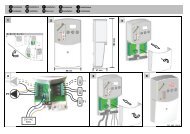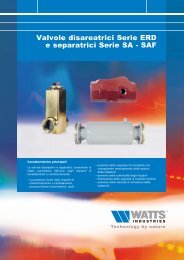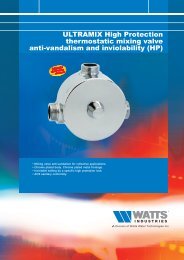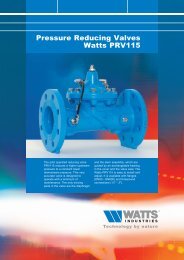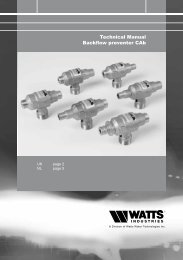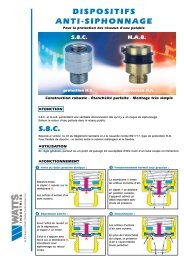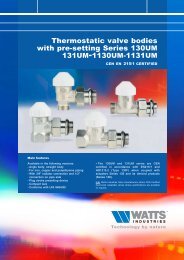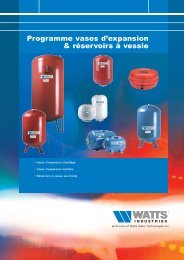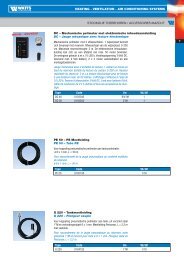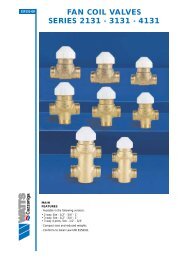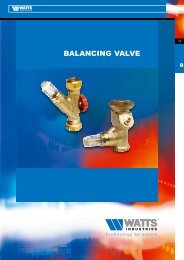4-way thermostat adaptable valves for two-pipes ... - Watts Industries
4-way thermostat adaptable valves for two-pipes ... - Watts Industries
4-way thermostat adaptable valves for two-pipes ... - Watts Industries
Create successful ePaper yourself
Turn your PDF publications into a flip-book with our unique Google optimized e-Paper software.
4-WAY THERMOSTAT ADAPTABLE VALVES<br />
Application<br />
These <strong>valves</strong> are designed <strong>for</strong> manual room temperature control using just one connection <strong>for</strong> water inlet/outlet<br />
to/from the heat emitter. They can also be used <strong>for</strong> automatic temperature control when coupled to <strong>thermostat</strong>ic<br />
actuators (Series 148, 148SD, 148CD) or else electrothermic actuators (Art. 22C). The use of <strong>thermostat</strong>ic<br />
<strong>valves</strong> allows installation of metering systems (see Sections on Measuring and metering systems) as required by<br />
Italian legislation (Act 10/91 Art. 26). The <strong>valves</strong> are provided with active memory presetting which, when using<br />
<strong>thermostat</strong>ic or thermoelectric actuators, enables exact balancing of the heating system.<br />
3<br />
Such balancing is obtained by turning the ring nut located under the handwheel in order to limit the plug stroke.<br />
Above all, when removing the handwheel <strong>for</strong> <strong>thermostat</strong>ting the system, the active memory presetting holds the<br />
balancing made permanently.<br />
Installation<br />
Valve selection is based on the type of system (one-pipe or <strong>two</strong>-pipe) as well as size of the connection to the<br />
radiator and connecting piping. Valves, Series 120B, 102M, can be installed on heat emitters supplied by<br />
copper or plastic <strong>pipes</strong>. When it is required to <strong>thermostat</strong> the system, merely unscrew the control handwheel from<br />
the valve and substitute it with a <strong>thermostat</strong>ic or electrothermic actuator by tightening the ring nut.<br />
All this can be done without any plumbing work and with the system running. As with all the <strong>two</strong>-pipe and<br />
one-pipe <strong>valves</strong>, likewise <strong>valves</strong> 120B, 102M should be connected in the bottom part of the heat emitter.<br />
In order to ensure correct <strong>thermostat</strong>ic operation (i.e. with <strong>thermostat</strong>ic actuator Series 148), the delivery pipe<br />
must be connected to the connection under the valve control handwheel which should al<strong>way</strong>s be mounted in the<br />
horizontal direction. In the case of panel type radiators, use the copper probe (art. RV141). When excluding and<br />
removing the radiator, it is also necessary to regulate the special built-in lockshield. All this should be done<br />
without interrupting circulation of the fluid in the rest of the ring circuit.<br />
Reliability of the <strong>thermostat</strong> <strong>adaptable</strong> <strong>valves</strong>, Series 120B, 102M, is guaranteed thanks to the 100% testing of<br />
the production which checks pressure tightness of the valve body and its components towards the outside and<br />
that of the plug during its flow shut-off function.<br />
102M<br />
4<br />
3<br />
1<br />
2<br />
Details<br />
5<br />
1) O-ring sealed straight tailpiece<br />
2) Probe holder insert<br />
3) Lockshield<br />
120B<br />
4) Presetting stuffing box nut, can be<br />
replaced with the system under<br />
pressure through art. 225.<br />
4<br />
3<br />
1<br />
2<br />
5) By-pass



